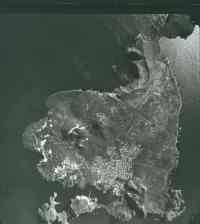Lava-Cooling Operations During the 1973 Eruption of Eldfell Volcano,
Heimaey, Vestmannaeyjar, Iceland
U.S. Geological Survey Open-File Report 97-724
|
|
Personal Commentary
by Próf. Þorbjörn Sigurgeirsson
The water-cooling of lava was a strongly debated subject while the operation was in progress. It was a very costly operation, but no one could have predicted what the outcome would be. Nevertheless, I suppose that now nobody will regret the cost.
The true value of the lava-cooling operations on Heimaey will probably never be known or about how conditions would be different if people had not turned out to battle against impending destruction. The inference that I have drawn is an educated guess and will only be judged by persons familiar with the local setting and with the behavior of the lava. It was not easy to estimate the effect water-cooling will have on lava movement on the first day after water-spraying operations began because of many uncertainties associated with gradual cooling of the lava. Several technical problems remain unsolved, but it would worthwhile to find satisfactory answers for them. One problem that requires a solution is to find a method for measuring the amount of steam that rises from the lava. Borehole measurements conclusively showed that the great force of the lava was contained by the effect of the water-cooling, but borehole measurements are a slow method that cannot be undertaken before the lava flow has stopped.
|
|
Figure 7. Click on figure for larger image with caption. |
On Heimaey, much damage was avoided by preventing fires or safeguarding houses from being crushed by the weight of tephra upon them. I cannot cite any numerical figures in this connection, but undoubtedly the cost can be calculated. As for the defense against flowing lava, the threat of total destruction of the town of Vestmannaeyjar and its harbor required an innovative approach using virtually untested methods. By the end of the volcanic eruption, however, it was clear that the increased thickness of the lava contributed to a smaller area of inundation than would have been anticipated, based on prior experience with unconstrained lava flows. It is also obvious that the lava came very close to destroying some very valuable fish-processing factories. The lava lies adjacent to the harbor, more than 1 km along the harbor entrance. If the lava were to have flowed 100 m more at some points, the harbor would have been blocked [fig. 7].
I have described here the lava-cooling [history] on Heimaey, without going into individual specifics of the operation. There will be accounts of specific aspects of the water-cooling operations by others [Valdimar Kr. Jónsson and Matthías Matthíasson, 1974]. It was an unusual and difficult operation, relying entirely on all those who worked in a disciplined manner and with selfless zeal demonstrated their energy and their ability to adapt to unique conditions. There is no question that a memorable heritage of pioneering spirit was displayed.
A volcanic eruption has long been considered to be a most awesome and destructive event upon certain districts, and on the whole there was very little that could be done to prevent it. No procedures have ever been perfected to safeguard against a volcanic eruption or against the destructive force of advancing lava such as occurred on Heimaey. In this case, however, the threatening catastrophe proved to be not so terrible and uncontrollable as had been initially feared.
The experience at Heimaey gives reason to suppose that we may be able to exert an effective influence upon the movement of lava if the conditions are favorable, if sufficient water is available, and provided that local material can be used to construct a protective rampart or dike of sufficient height on the flowing lava. In this way, and if both the time and the morphology of the landscape permits, lava may be forced to circumvent valuable land and be guided to where it can do the least damage. Similarly, efforts could be directed at having the lava pile up into a thick mound and, in this way, hinder it from spreading (fig. 7).
Iceland was created by volcanic eruptions in the past, and to these we gratefully owe our existence. For the Icelander, therefore, it is not fair to look upon a volcanic eruption first and foremost as an agent of terror and destruction. In the Heimaey eruption, there was certainly a severe loss, but we are already seeking different ways to increase the fertility of our soil and to improve our harbor. There is much work to do along these lines, and to reshape our land as it was at the time of first settlement (874 A.D.).
1Þorbjörn Sigurgeirsson, 1974, Hraunkæling [Lava cooling]: Tíminn, 19 January 1974, p. 8, 9, and 13. Slightly revised version of a lecture given by Prof. Thorbjörn Sigurgeirsson at Norræna húsið; [Nordic House], Reykjavík, Iceland, on 4 November 1973. English translation by unknown U.S. Department of State translator. Additional translation and edit by Richard S. Williams, Jr., U.S. Geological Survey, Woods Hole Field Center, Woods Hole, Massachusetts 025431598.
2Jón Steingrímsson (Rev.), 1973, Eldritið [Volcano essay]; in Æfisagan og önnur rit [Biography and other essays]: Reykjavík, Helgafell, p. 339390. See also Jón Steingrímsson, 1907, Fullkomið skrif um Siðueld [Complete account of the Síðu eruption]; edited by þorvaldur Thoroddsen; in Safn til Sögu Íslands og Íslenzkra bókmennta (Copenhagen and Reykjavík), v. 4, p. 173.
